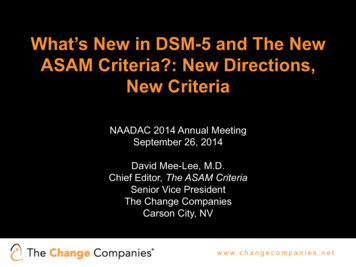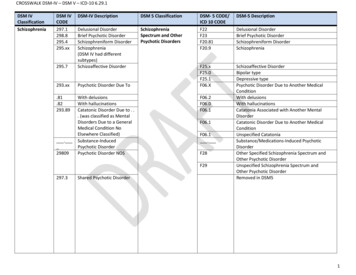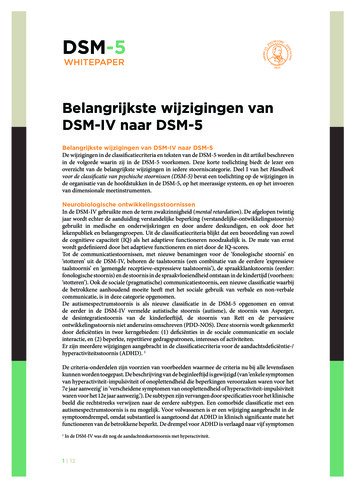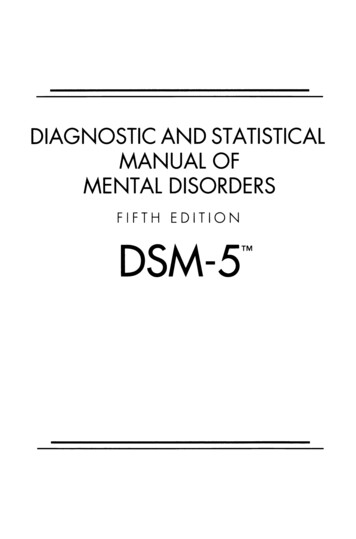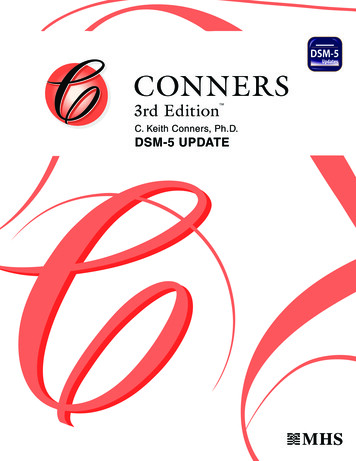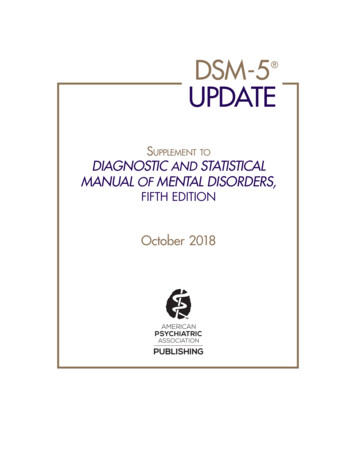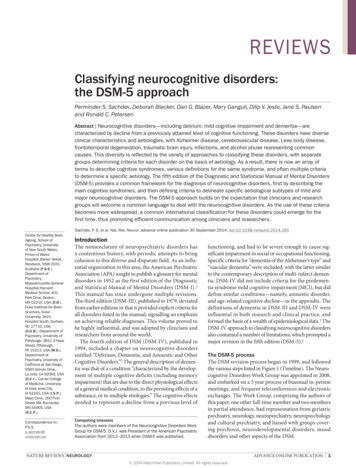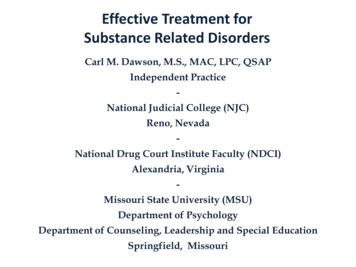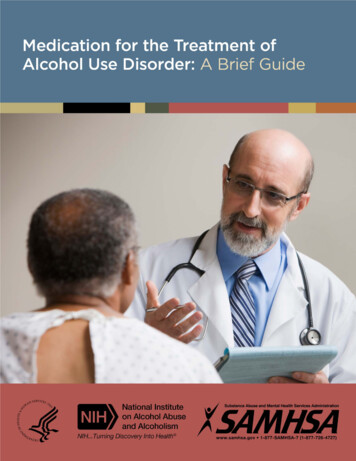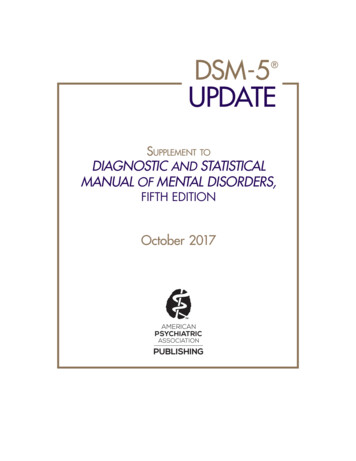
Transcription
DSM-5UPDATE Supplement toDIAGNOSTIC AND STATISTICALMANUAL OF MENTAL DISORDERS,FIFTH EDITIONOctober 2017
DSM-5 UpdateOctober 2017Supplement toDiagnostic and Statistical Manual of Mental Disorders, Fifth EditionCopyright 2017 American Psychiatric Association. All rights reserved. Unless authorized inwriting by the American Psychiatric Association (APA), no part of this supplement may bereproduced or used in a manner inconsistent with the APA’s copyright. This prohibition applies tounauthorized uses or reproductions in any form, including electronic applications.Correspondence regarding copyright permissions should be directed to DSM Permissions,American Psychiatric Association Publishing, 1000 Wilson Boulevard, Suite 1825, Arlington, VA22209-3901.This supplement and the digital versions of DSM-5 (including the DSM-5 Diagnostic CriteriaMobile App, DSM-5 eBook, and DSM-5 on PsychiatryOnline.org) reflect any updates todiagnostic criteria and related text; coding updates, changes, or corrections; and any otherinformation necessary for compensation in mental health practice. This supplement containsICD-10-CM updates that become effective on October 1, 2017. It also includes content fromprior updates that remains relevant to compensation and current clinical practice. This supplementis located at: dsm.DSM and DSM-5 are registered trademarks of the American Psychiatric Association. Use of theseterms is prohibited without permission of the American Psychiatric Association.ICD-9-CM codes were used for coding purposes in the United States through September 30,2015. These codes can no longer be used in the United States. ICD-10-CM codes are used forcoding purposes in the United States as of October 1, 2015.
ContentsOctober 2017 ICD-10-CM Coding Updates at a Glance . 1Prior ICD-10-CM Coding Updates at a Glance . 5October 2016 ICD-10-CM Coding Updates at a Glance . 5October 2015 ICD-10-CM Coding Updates at a Glance . 6Criteria Updates . 7Neurodevelopmental Disorders . 7Autism Spectrum Disorder: Criterion A [August 2015]Schizophrenia Spectrum and Other Psychotic Disorders . 7Brief Psychotic Disorder: “With Peripartum Onset” Specifier [August 2015]Bipolar and Related Disorders. 7Bipolar I Disorder: Manic Episode, Criterion A [August 2015]Bipolar I Disorder: Hypomanic Episode, Criterion F [August 2015]Bipolar II Disorder: Hypomanic Episode, Criterion F [August 2015]Bipolar II Disorder: “With Melancholic Features” and “With Atypical Features”Specifiers [August 2015]Bipolar II Disorder: “With Seasonal Pattern” Specifier [August 2015]Bipolar II Disorder: Severity Specifier [August 2015]Specifiers for Bipolar and Related Disorders: Severity Specifiers [August 2015]Depressive Disorders . 10Major Depressive Disorder: “With Mixed Features” Specifier, Criterion A [August 2015]Specifiers for Depressive Disorders: “With Seasonal Pattern” Specifier,Criterion D Note [August 2015]Trauma- and Stressor-Related Disorders . 10Adjustment Disorder: Addition of Acute and Persistent Specifiers [March 2014]Alternative DSM-5 Model for Personality Disorders . 11Obsessive-Compulsive Personality Disorder: Proposed Diagnostic Criterion B1[August 2015]Conditions for Further Study . 11Depressive Episodes With Short-Duration Hypomania: Proposed Criterion A[August 2015]Text Updates. 12Schizophrenia Spectrum and Other Psychotic Disorders . 12Delusional Disorder: Subtypes [August 2015]Depressive Disorders . 12Disruptive Mood Dysregulation Disorder: Development and Course [August 2015]Persistent Depressive Disorder: Differential Diagnosis [August 2015]Anxiety Disorders . 13Generalized Anxiety Disorder: Differential Diagnosis [August 2015]
Trauma- and Stressor-Related Disorders . 13Acute Stress Disorder: Differential Diagnosis [August 2015]Somatic Symptom and Related Disorders. 13Somatic Symptom Disorder: Differential Diagnosis [August 2015]October 2017 ICD-10-CM Coding Updates in Detail . 14Feeding and Eating Disorders . 14Avoidant/Restrictive Food Intake DisorderSubstance-Related and Addictive Disorders . 14Alcohol Use Disorder Course SpecifiersCannabis Use Disorder Course SpecifiersPhencyclidine Use Disorder Course SpecifiersOther Hallucinogen Use Disorder Course SpecifiersInhalant Use Disorder Course SpecifiersOpioid Use Disorder Course SpecifiersSedative, Hypnotic, or Anxiolytic Use Disorder Course SpecifiersStimulant Use Disorder Course Specifiers (for Amphetamine-Type Substance Use Disorder,Cocaine Use Disorder, and Other or Unspecified Stimulant Use Disorder)Tobacco Use Disorder Course SpecifiersOther (or Unknown) Substance Use Disorder Course SpecifiersPrior ICD-10-CM Coding Updates in Detail .32Neurodevelopmental Disorders . 32Language Disorder [effective October 1, 2015]Social (Pragmatic) Communication Disorder [effective October 1, 2016]Bipolar and Related Disorders. 33Bipolar I Disorder, Current or most recent episode hypomanic [effective October 1, 2015]In partial remissionIn full remissionDepressive Disorders . 33Disruptive Mood Dysregulation Disorder [effective October 1, 2016]Premenstrual Dysphoric Disorder [effective October 1, 2016]Other Specified Depressive Disorder [effective October 1, 2016]Obsessive-Compulsive and Related Disorders . 35Obsessive-Compulsive Disorder [effective October 1, 2016]Hoarding Disorder [effective October 1, 2016]Trichotillomania (Hair-Pulling Disorder) [effective October 1, 2015]Excoriation (Skin-Picking) Disorder [effective October 1, 2016]Other Specified Obsessive-Compulsive and Related Disorder [effective October 1, 2016]Unspecified Obsessive-Compulsive and Related Disorder [effective October 1, 2016]Feeding and Eating Disorders . 38Pica, in adults [effective October 1, 2016]Avoidant/Restrictive Food Intake Disorder [effective October 1, 2016;see revised code effective October 1, 2017]Binge-Eating Disorder [effective October 1, 2016]Other Specified Feeding or Eating Disorder [effective October 1, 2016]
Sleep-Wake Disorders . 40Insomnia Disorder [effective October 1, 2015]Hypersomnolence Disorder [effective October 1, 2015]Gender Dysphoria . 41Gender Dysphoria in Adolescents and Adults [effective October 1, 2016]Disruptive, Impulse-Control, and Conduct Disorders . 41Kleptomania [effective October 1, 2015]Neurocognitive Disorders . 42Major Neurocognitive Disorder Due to Alzheimer’s Disease [effective October 1, 2015]Major Frontotemporal Neurocognitive Disorder [effective October 1, 2015]Major Neurocognitive Disorder With Lewy Bodies [effective October 1, 2015]Major Vascular Neurocognitive Disorder [effective October 1, 2015]Major Neurocognitive Disorder Due to Parkinson’s Disease [effective October 1, 2015]
October 2017 ICD-10-CM Coding Updates at a GlanceListing of DSM-5 Diagnoses and New ICD-10-CM Codes as Ordered in theDSM-5 ClassificationThe following new ICD-10-CM codes are to be used for coding purposes in the United States startingOctober 1, 2017.For ICD-10-CM Coding Updates in Detail, which list each DSM-5 and DSM-5 Desk Reference page where thecode appears, see pp. 14–31.DSM-5 RecommendedICD-10-CM Code for usethrough September 30,2017DSM-5 RecommendedICD-10-CM Code for usebeginning October 1,2017Avoidant/Restrictive Food Intake DisorderAlcohol Use Disorder, MildF50.89F10.10F50.82F10.10Alcohol Use Disorder, Mild, In early or sustainedremissionAlcohol Use Disorder, l Use Disorder, Moderate, In early orsustained remissionAlcohol Use Disorder, SevereAlcohol Use Disorder, Severe, In early orsustained remissionCannabis Use Disorder, MildCannabis Use Disorder, Mild, In early or sustainedremissionCannabis Use Disorder, ModerateCannabis Use Disorder, Moderate, In early orsustained remissionCannabis Use Disorder, SevereCannabis Use Disorder, Severe, In early orsustained remissionPhencyclidine Use Disorder, MildPhencyclidine Use Disorder, Mild, In early orsustained remissionPhencyclidine Use Disorder, ModeratePhencyclidine Use Disorder, Moderate, In early orsustained remissionPhencyclidine Use Disorder, SeverePhencyclidine Use Disorder, Severe, In early orsustained remissionOther Hallucinogen Use Disorder, MildOther Hallucinogen Use Disorder, Mild, In early orsustained remissionDSM‐5 Update (October 2017), page 1 of 51Copyright 2017 American Psychiatric Association. All rights reserved.
October 2017 ICD-10-CM Coding Updates at a Glance (continued)DSM-5 RecommendedICD-10-CM Code for usethrough September 30,2017DSM-5 RecommendedICD-10-CM Code for usebeginning October 1,2017Other Hallucinogen Use Disorder, ModerateF16.20F16.20Other Hallucinogen Use Disorder, Moderate, Inearly or sustained remissionOther Hallucinogen Use Disorder, SevereF16.20F16.21F16.20F16.20Other Hallucinogen Use Disorder, Severe, In earlyor sustained remissionInhalant Use Disorder, ioid Use Disorder, Severe, In early or sustainedremissionF11.20F11.21Sedative, Hypnotic, or Anxiolytic Use Disorder,MildF13.10F13.10Sedative, Hypnotic, or Anxiolytic Use Disorder,Mild, In early or sustained remissionF13.10F13.11Sedative, Hypnotic, or Anxiolytic Use Disorder,ModerateF13.20F13.20Sedative, Hypnotic, or Anxiolytic Use Disorder,Moderate, In early or sustained remissionF13.20F13.21Sedative, Hypnotic, or Anxiolytic Use Disorder,SevereF13.20F13.20Sedative, Hypnotic, or Anxiolytic Use Disorder,Severe, In early or sustained remissionF13.20F13.21DisorderInhalant Use Disorder, Mild, In early or sustainedremissionInhalant Use Disorder, ModerateInhalant Use Disorder, Moderate, In early orsustained remissionInhalant Use Disorder, SevereInhalant Use Disorder, Severe, In early orsustained remissionOpioid Use Disorder, MildOpioid Use Disorder, Mild, In early or sustainedremissionOpioid Use Disorder, ModerateOpioid Use Disorder, Moderate, In early orsustained remissionOpioid Use Disorder, SevereDSM‐5 Update (October 2017), page 2 of 51Copyright 2017 American Psychiatric Association. All rights reserved.
October 2017 ICD-10-CM Coding Updates at a Glance (continued)DSM-5 RecommendedICD-10-CM Code for usethrough September 30,2017DSM-5 RecommendedICD-10-CM Code for usebeginning October 1,2017Amphetamine-type Substance Use Disorder, MildF15.10F15.10Amphetamine-type Substance Use Disorder, Mild,In early or sustained remissionF15.10F15.11Amphetamine-type Substance Use Disorder,ModerateF15.20F15.20Amphetamine-type Substance Use Disorder,Moderate, In early or sustained remissionF15.20F15.21Amphetamine-type Substance Use Disorder,SevereF15.20F15.20Amphetamine-type Substance Use Disorder,Severe, In early or sustained remissionCocaine Use Disorder, MildF15.20F15.21F14.10F14.10Cocaine Use Disorder, Mild, In early or sustainedremissionCocaine Use Disorder, F14.20Cocaine Use Disorder, Severe, In early orsustained remissionF14.20F14.21Other or Unspecified Stimulant Use Disorder, MildF15.10F15.10Other or Unspecified Stimulant Use Disorder, Mild,In early or sustained remissionF15.10F15.11Other or Unspecified Stimulant Use Disorder,ModerateF15.20F15.20Other or Unspecified Stimulant Use Disorder,Moderate, In early or sustained remissionF15.20F15.21Other or Unspecified Stimulant Use Disorder,SevereF15.20F15.20Other or Unspecified Stimulant Use Disorder,Severe, In early or sustained remissionF15.20F15.21DisorderCocaine Use Disorder, Moderate, In early orsustained remissionCocaine Use Disorder, SevereDSM‐5 Update (October 2017), page 3 of 51Copyright 2017 American Psychiatric Association. All rights reserved.
October 2017 ICD-10-CM Coding Updates at a Glance (continued)DSM-5 RecommendedICD-10-CM Code for usethrough September 30,2017DSM-5 RecommendedICD-10-CM Code for usebeginning October 1,2017Tobacco Use Disorder, ModerateF17.200F17.200Tobacco Use Disorder, Moderate, In early orsustained remissionTobacco Use Disorder, SevereF17.200F17.201F17.200F17.200Tobacco Use Disorder, Severe, In early orsustained remissionF17.200F17.201Other (or Unknown) Substance Use Disorder, MildF19.10F19.10Other (or Unknown) Substance Use Disorder,Mild, In early or sustained remissionF19.10F19.11Other (or Unknown) Substance Use Disorder,ModerateF19.20F19.20Other (or Unknown) Substance Use Disorder,Moderate, In early or sustained remissionF19.20F19.21Other (or Unknown) Substance Use Disorder,SevereF19.20F19.20Other (or Unknown) Substance Use Disorder,Severe, In early or sustained remissionF19.20F19.21DisorderDSM‐5 Update (October 2017), page 4 of 51Copyright 2017 American Psychiatric Association. All rights reserved.
Prior ICD-10-CM Coding Updates at a GlanceOctober 2016 ICD-10-CM Coding Updates at a GlanceThe following new ICD-10-CM codes are to be used for coding purposes in the United States startingOctober 1, 2016.For ICD-10-CM Coding Updates in Detail, which list each DSM-5 and DSM-5 Desk Reference page where thecode appears, see pp. 32–51.Listing of DSM-5 Diagnoses and October 2016 ICD-10-CM Coding UpdateOriginal CodeDisorderfor use throughSeptember 30, 2016New Codefor use beginningOctober 1, 2016Social (Pragmatic) Communication DisorderF80.89F80.82Disruptive Mood Dysregulation DisorderF34.8F34.81Premenstrual Dysphoric DisorderN94.3F32.81Other Specified Depressive DisorderF32.8F32.89Obsessive-Compulsive DisorderF42F42.2Hoarding DisorderF42F42.3Excoriation (Skin-Picking) DisorderL98.1F42.4Other Specified Obsessive-Compulsive and Related DisorderF42F42.8Unspecified Obsessive-Compulsive and Related DisorderF42F42.9Pica, in adultsF50.8F50.89Avoidant/Restrictive Food Intake Disorder**F50.8[F50.89**]Binge-Eating DisorderF50.8F50.81Other Specified Feeding or Eating DisorderF50.8F50.89Gender Dysphoria in Adolescents and AdultsF64.1F64.0**Note that the ICD-10-CM code for Avoidant/Restrictive Food Intake Disorder changed onOctober 1, 2017, to F50.82. (The code F50.89 should no longer be used for this disorder.)Alphabetical Listing of DSM-5 Diagnoses and October 2016 ICD-10-CM-Coding UpdateOriginal CodeNew CodeDisorderfor use throughfor use beginningSeptember 30, 2016October 1, 2016Avoidant/Restrictive Food Intake Disorder**F50.8F50.89**Binge-Eating DisorderF50.8F50.81Disruptive Mood Dysregulation DisorderF34.8F34.81Excoriation (Skin-Picking) DisorderL98.1F42.4Gender Dysphoria in Adolescents and AdultsF64.1F64.0Hoarding DisorderF42F42.3Obsessive-Compulsive DisorderF42F42.2Other Specified Depressive DisorderF32.8F32.89Other Specified Feeding or Eating DisorderF50.8F50.89Other Specified Obsessive-Compulsive and Related DisorderF42F42.8Pica, in adultsF50.8F50.89Premenstrual Dysphoric DisorderN94.3F32.81Social (Pragmatic) Communication DisorderF80.89F80.82Unspecified Obsessive-Compulsive and Related DisorderF42F42.9**Note that the ICD-10-CM code for Avoidant/Restrictive Food Intake Disorder changed onOctober 1, 2017, to F50.82. (The code F50.89 should no longer be used for this disorder.)DSM‐5 Update (October 2017), page 5 of 51Copyright 2017 American Psychiatric Association. All rights reserved.
October 2015 ICD-10-CM Coding Updates at a GlanceFor ICD-10-CM Coding Updates in Detail, see pp. 32–51.*These codes are used for coding purposes in the United States since October 1, 2015.DisorderOriginalUpdate*Language DisorderF80.9F80.2Bipolar I Disorder, Current or most recent episodeF31.73F31.71hypomanic, In partial remissionBipolar I Disorder, Current or most recent episodeF31.74F31.72hypomanic, In full remissionTrichotillomania (Hair-Pulling Disorder)F63.2F63.3Insomnia DisorderG47.00F51.01Hypersomnolence DisorderG47.10F51.11KleptomaniaF63.3F63.2Major Neurocognitive Disorders With Possible EtiologiesThe following coding updates ensure that insurance reimbursement can be obtained when the specifier “Withbehavioral disturbance” is used for the possible major neurocognitive disorders. The possible majorneurocognitive disorders should be coded in the same way as their respective probable major neurocognitivedisorders, as noted below. For excerpts of the DSM-5 sections with these changes, see pp. 42–51 of thisDSM-5 Update.Major Neurocognitive Disorder Possibly Due toG31.9F01.51 WithVascular DiseasebehavioralMajor Neurocognitive Disorder Due to PossibleAlzheimer’s Disease(Note: Code first G30.9 Alzheimer’s disease.)No coding ofetiological medicalconditionMajor Neurocognitive Disorder Due to PossibleFrontotemporal Lobar Degeneration(Note: Code first G31.09 frontotemporal disease.)G31.9Major Neurocognitive Disorder With Possible LewyBodies (Note: Code first G31.83 Lewy body disease.)Major Neurocognitive Disorder Possibly Due toParkinson’s Disease(Note: Code first G20 Parkinson’s disease.)disturbanceorF01.50 WithoutbehavioraldisturbanceCode etiologicalmedical conditionfirst (noted at leftwith each disorder)then codeF02.81 WithbehavioraldisturbanceorF02.80 WithoutbehavioraldisturbanceDSM‐5 Update (October 2017), page 6 of 51Copyright 2017 American Psychiatric Association. All rights reserved.
Criteria UpdatesThis content is unchanged from the prior DSM-5 Update (August 2015).Key: Underlined text is to be added; crossed-out text is to be deleted.Neurodevelopmental DisordersAutism Spectrum Disorder: Criterion A [August 2015](DSM-5, p. 50; Desk Reference, p. 27)As printedA. Persistent deficits in social communication and social interaction across multiple contexts,as manifested by the following, currently or by history (examples are illustrative, notexhaustive; see text):As updatedReason forupdateA. Persistent deficits in social communication and social interaction across multiple contexts,as manifested by all of the following, currently or by history (examples are illustrative, notexhaustive; see text):This update clarifies that all three of the Criterion A items are required.Schizophrenia Spectrum and Other Psychotic DisordersBrief Psychotic Disorder: “With Peripartum Onset” Specifier [August 2015](DSM-5, p. 94; Desk Reference, p. 48)As printedWith postpartum onset: if onset is during pregnancy or within 4 weeks postpartumAs updatedWith postpartum peripartum onset: if onset is during pregnancy or within 4 weekspostpartumCorresponding update in DSM-5 Classification, Brief Psychotic Disorder(DSM-5, p. xv; Desk Reference, p. xii)As printedSpecify if: With marked stressor(s), Without marked stressor(s), With postpartum onsetAs updatedSpecify if: With marked stressor(s), Without marked stressor(s), With postpartum peripartumonsetReason forupdate“Peripartum” rather than “postpartum” is correct.Bipolar and Related DisordersBipolar I Disorder: Manic Episode, Criterion A [August 2015](DSM-5, p. 124; Desk Reference, p. 65)As printedA. A distinct period of abnormally and persistently elevated, expansive, or irritable mood andabnormally and persistently increased goal-directed activity or energy, lasting at least 1 weekand present most of the day, nearly every day (or any duration if hospitalization is necessary).As updatedReason forupdateA. A distinct period of abnormally and persistently elevated, expansive, or irritable mood andabnormally and persistently increased goal-directed activity or energy, lasting at least 1 weekand present most of the day, nearly every day (or any duration if hospitalization is necessary).The abnormally and persistent increased activity required in Criterion A does not have to begoal-directed. Increase in goal-directed activity is required to meet Criterion B6.DSM‐5 Update (October 2017), page 7 of 51Copyright 2017 American Psychiatric Association. All rights reserved.
Bipolar I Disorder: Hypomanic Episode, Criterion F [August 2015](DSM-5, p. 125; Desk Reference, p. 67)Bipolar II Disorder: Hypomanic Episode, Criterion F [August 2015](DSM-5, p. 133; Desk Reference, p. 72)As printedF. The episode is not attributable to the physiological effects of a substance (e.g., a drug ofabuse, a medication, other treatment).As updatedReason forupdateF. The episode is not attributable to the physiological effects of a substance (e.g., a drug ofabuse, a medication, other treatment) or another medical condition.“Another medical condition” added so that Criterion F conforms to the wording of other DSM-5criteria that rule out organic causes.Bipolar II Disorder: “With Melancholic Features” and “With Atypical Features” Specifiers [August 2015](DSM-5, p. 135; Desk Reference, p. 75)As printedWith rapid cyclingWith mood-congruent psychotic featuresAs updated(DSM-5)With rapid cyclingWith melancholic features (p. 151)With atypical features (pp. 151–152)With mood-congruent psychotic features(DeskReference)With rapid cyclingWith melancholic features (pp. 86–87)With atypical features (pp. 87–88)With mood-congruent psychotic featuresReason forupdate“With melancholic features” and “with atypical features” apply to major depressive episodes inbipolar II disorder.Bipolar II Disorder: “With Seasonal Pattern” Specifier [August 2015](DSM-5, p. 135; Desk Reference, p. 75)As printed: Applies only to the pattern of major depressive episodes.As updatedReason forupdate: Applies only to the pattern of major depressive episodes.“With seasonal pattern” applies to all mood episodes: manic, hypomanic, and major depressiveepisodes.Additional update to “with seasonal pattern” specifier, Criterion D Note, second paragraph, second sentence(DSM-5, pp. 153–154; Desk Reference, p. 91)As printedThis specifier does not apply to those situations in which the pattern is better explained byseasonally linked psychosocial stressors (e.g., seasonal unemployment or school schedule).Major depressive episodes that occur in a seasonal pattern are often characterized byprominent energy, hypersomnia, overeating, weight gain, and a craving for carbohydrates.As updatedThis specifier does not apply to those situations in which the pattern is better explained byseasonally linked psychosocial stressors (e.g., seasonal unemployment or school schedule).Major depressive episodes that occur in a seasonal pattern are often characterized byprominent loss of energy, hypersomnia, overeating, weight gain, and a craving forcarbohydrates.Reason forupdate“Loss of energy” is correct.DSM‐5 Update (October 2017), page 8 of 51Copyright 2017 American Psychiatric Association. All rights reserved.
Bipolar II Disorder: Severity Specifier [August 2015](DSM-5, p. 135; Desk Reference, p. 75)As printedSpecify severity if full criteria for a mood episode are currently met:As updatedSpecify severity if full criteria for a mood major depressive episode are currently met:Corresponding update in DSM-5 Classification, Bipolar II Disorder(DSM-5, p. xvi; Desk Reference, p. xiv)As printedSpecify severity if full criteria for a mood episode are currently met: Mild, Moderate, SevereAs updatedSpecify severity if full criteria for a mood major depressive episode are currently met: Mild,Moderate, SevereReason forupdate“Mild,” “moderate,” and “severe” only apply to major depressive episodes in bipolar II disorder.Specifiers for Bipolar and Related Disorders: Severity Specifiers [August 2015](DSM-5, p. 154; Desk Reference, p. 92)As printedIn full remission: During the past 2 months, no significant signs or symptoms of thedisturbance were present.Specify current severity:Severity is based on the number of criterion symptoms, the severity of those symptoms, andthe degree of functional disability.Mild: Few, if any, symptoms in excess of those required to meet the diagnostic criteria arepresent, the intensity of the symptoms is distressing but manageable, and the symptomsresult in minor impairment in social or occupational functioning.Moderate: The number of symptoms, intensity of symptoms, and/or functional impairmentare between those specified for “mild” and “severe.”Severe: The number of symptoms is substantially in excess of those required to make thediagnosis, the intensity of the symptoms is seriously distressing and unmanageable, andthe symptoms markedly interfere with social and occupational functioning.As updatedIn full remission: During the past 2 months, no significant signs or symptoms of thedisturbance were present.Specify current severity of manic episode:Severity is based on the number of criterion symptoms, the severity of those symptoms, andthe degree of functional disability.Mild: Minimum symptom criteria are met for a manic episode.Moderate: Very significant increase in activity or impairment in judgment.Severe: Almost continual supervision is required in order to prevent physical harm to selfor others.Specify current severity of major depressive episode:Severity is based on the number of criterion symptoms, the severity of those symptoms, andthe degree of functional disability.Mild: Few, if any, symptoms in excess of those required to meet the diagnostic criteria arepresent, the intensity of the symptoms is distressing but manageable, and the symptomsresult in minor impairment in social or occupational functioning.Moderate: The number of symptoms, intensity of symptoms, and/or functional impairmentare between those specified for “mild” and “severe.”Severe: The number of symptoms is substantially in excess of those required to make thediagnosis, the intensity of the symptoms is seriously distressing and unmanageable, andthe symptoms markedly interfere with social and occupational functioning.Reason forupdateSeparate severity specifiers for manic episode are added to enhance clarity. The severityspecifiers for manic episode are adapted from DSM-IV.DSM‐5 Update (October 2017), page 9 of 51Copyright 2017 American Psychiatric Association. All rights reserved.
Depressive DisordersMajor Depressive Disorder: “With Mixed Features” Specifier, Criterion A [August 2015](DSM-5, p. 184; Desk Reference, p. 108)As printedA. At least three of the following manic/hypomanic symptoms are present nearly every dayduring the majority of days of a major depressive episode:As updatedReason forupdateA. At least three of the following manic/hypomanic symptoms are present nearly every dayduring the majority of days of a major depressive episode:“Nearly every day” in Criterion A for mixed features is incorrect.Specifiers for Depressive Disorders: “With Seasonal Pattern” Specifier, Criterion D Note(second paragraph) [August 2015](DSM-5, p. 187; Desk Reference, p. 113)As printedThis specifier does not apply to those situations in which the pattern is better explained byseasonally linked psychosocial stressors (e.g., seasonal unemployment or school schedule).Major depressive episodes that occur in a seasonal pattern are often characterized byprominent energy, hypersomnia, overeating, weight gain, and a craving for carbohydrates.As updatedReason forupdateThis specifier does not apply to those situations in which the pattern is better explained byseasonally linked psychosocial stressors (e.g., seasonal unemployment or school schedule).Major depressive episodes that occur in a seasonal pattern are often characterized byprominent loss of energy, hypersomnia, overeating, weight gain, and a craving forcarbohydrates.“Loss of energy” is correct.Trauma- and Stressor-Related DisordersAdjustment Disorder: Add specifiers for Adjustment Disorders [March 2014](DSM-5: pp. xx, 287; Desk Reference: pp. xix, 152)DSM-5 Classification (DSM-5: p. xx; Desk Reference: p. xix)As printed. ( . ) Adjustment DisordersSpecify whether:(F43.21)With depressed mood(F43.22)With anxiety [codes and subtypes continue as printed](F43.20)UnspecifiedAs updated. ( . ) Adjustment DisordersSpecify whether:(F43.21)With depressed mood(F43.22)With anxiety [codes and subtypes continue as printed](F43.20)UnspecifiedSpecify if: Acute, Persistent (chronic)(continued)DSM‐5 Update (October 2017), page 10 of 51Copyright 2017 American Psychiatric Association. All rights reserved.
Trauma- and Stressor-Related Disorders (continued)Adjustment Disorder: Add specifiers for Adjustment Disorders [March 2014](DSM-5: pp. xx, 287; Desk Reference: pp. xix, 152)Criteria (DSM-5: p. 287; Desk R
This supplement and the digital versions of DSM-5 (including the DSM-5 Diagnostic Criteria Mobile App, DSM-5 eBook, and DSM-5 on PsychiatryOnline.org) reflect any updates to diagnostic criteria and related text; coding updates, changes, or corrections; and any other information necessary for compensation in mental health practice.
